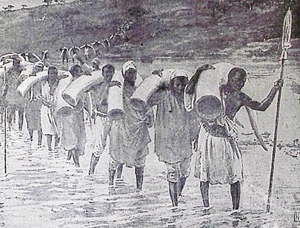The earliest Kenyan roads
Before the advent of the railway and automobiles in Kenya the main mode of transport on the mainland from Mombasa to the interior parts of Kenya was walking, ox-drawn wagon to carry cargo, horse-drawn carriage, and mules. The vital means of transporting bulky luggage-oxen and mules- were constantly infested and killed by tse tse flies. For protection against tse tse fly bites the oxen and mule were wrapped in Americani- a cotton cloth brought America to Zanzibar then Mombasa by merchants.
Camels were used as means of transport in the 19th century and early 20th century. Owing to their ability to survive in arid and semi-arid regions such as north-east Kenya they are still the main means of transport to date. Donkeys are still used in remote areas to transport water, animal feed, firewood, etc.
The first road built in Kenya was the Mackinnon-Scalter road, a 1000km ox cart earth track from Mombasa to Busia whose construction started in 1890 by the Imperial British East Africa company (IBEA). Prior its construction traders (in goods and slaves) and explorers to the interior parts of Kenya used caravan routes. Completion of the construction of the road was taken over by the British government following financial difficulties facing IBEA.
In 1896 the British government started building the Kenya-Uganda railway from the port of Mombasa to lake Victoria, Kisumu. The railway reached Port Florence (Kisumu) in 1901 and between 1902 and 1903 reached Kampala. The Mackinnon-Scalter road as means of long distance travel fell into disuse between 1896 and 1901 after the Uganda railway overtook it. The railway replaced porters as a means of transport from Mombasa to the interior and back.
The first automobile in Kenya, the De Dion-Bouton, was lowered from a steamship at Mombasa’s old port in December 1903. There were several challenges facing the pioneers motorists such as George Wilson; there were no garages, no petrol pumps, and only one major road in the entire country, the Mackinnon-Scalter road. The De Dion-Bouton was the only car at the time and its petrol was shipped in the same ship the it came packed in four-gallon tins, similar to the kerosene debes, the mode of packaging at the time.
Though the map to the interior was not complicated, the environment was not forgiving. The road cut across the Nyika (Taru desert scrubland) past Kilimanjaro, through the Kapiti plains to the bamboo covered Kikuyu hills, then down through the Great Rift Valley (Maasai country) and over the forested highlands to the Nile Basin (Lake Victoria). Penetrating the interior presented forbidding sections on the road creating a barrier between Mombasa and the interior. It was 23 years since the arrival of the first car at the port of Mombasa in 1903 before a petrol vehicle completed the journey from Mombasa to Nairobi. Many of the cars used in the interior were transported there by rail because the road journey was long, slow and difficult. Douglas Galton-Fenzi in a Riley 12/50 was the first person to drive between Nairobi and Mombasa in 1926.
The first tarmac road in Kenya was introduced in 1922. A 20-metre long test strip was bitumenised and soon the centre of Nairobi. By 1930 asphalt had spread to other towns such as Mombasa, Nakuru, Eldoret and Kisumu.

